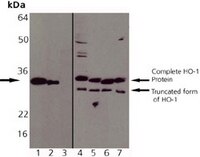374090 Sigma-AldrichAnti-Heme Oxygenase-1 (1-30) Rabbit pAb
Anti-Heme Oxygenase-1 (1-30), rabbit polyclonal, recognizes the ~32 kDa HO-1 protein. Does not cross-react with HO-2. It is validated for use in Western blotting and immunoprecipitation.
More>> Anti-Heme Oxygenase-1 (1-30), rabbit polyclonal, recognizes the ~32 kDa HO-1 protein. Does not cross-react with HO-2. It is validated for use in Western blotting and immunoprecipitation. Less<<Anti-Heme Oxygenase-1 (1-30) Rabbit pAb MSDS (material safety data sheet) or SDS, CoA and CoQ, dossiers, brochures and other available documents.
同义词: Anti-HO-1, Anti-Hsp32
Recommended Products
概述
| Replacement Information |
|---|
重要规格表
| Species Reactivity | Host | Antibody Type |
|---|---|---|
| Ca, Ht, H, Mk, M, R | Rb | Polyclonal Antibody |
价格及供货情况
| 产品目录编号 | 库存情况 | 包装 | 数量 / 包装 | 价格 | 数量 | |
|---|---|---|---|---|---|---|
| 374090-100ULCN |
|
塑胶安瓿;塑胶针药瓶 | 100 ul |
|
— |
| Product Information | |
|---|---|
| Form | Liquid |
| Formulation | In PBS, 50% glycerol, pH 7.2. |
| Preservative | ≤0.1% sodium azide |
| Quality Level | MQ100 |
| Physicochemical Information |
|---|
| Dimensions |
|---|
| Materials Information |
|---|
| Toxicological Information |
|---|
| Safety Information according to GHS |
|---|
| Safety Information | |
|---|---|
| S Phrase | S: 24/25-36-A09 Avoid contact with skin and eyes. Wear suitable protective clothing. |
| Product Usage Statements |
|---|
| Packaging Information |
|---|
| Transport Information |
|---|
| Supplemental Information |
|---|
| Specifications |
|---|
| Global Trade Item Number | |
|---|---|
| 产品目录编号 | GTIN |
| 374090-100ULCN | 04055977191172 |
Documentation
Anti-Heme Oxygenase-1 (1-30) Rabbit pAb MSDS
| 职位 |
|---|
Anti-Heme Oxygenase-1 (1-30) Rabbit pAb 分析证书
| 标题 | 批号 |
|---|---|
| 374090 |
参考
| 参考信息概述 |
|---|
| Maines, M.D. 1988 FASEB J. 2, 2557. Kutty, R.K., et al. 1994. J. Cell Physiol. 159, 371. Yoshida, T., et al. 1988. Eur. J. Biochem. 171, 457. Trakshel, G.M., et al. 1986 J. Biol. Chem. 261, 11131. |








